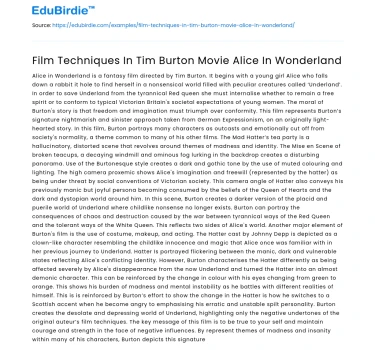Alice in Wonderland is a fantasy film directed by Tim Burton. It begins with a young girl Alice who falls down a rabbit it hole to find herself in a nonsensical world filled with peculiar creatures called ‘Underland’. In order to save Underland from the tyrannical Red queen she must internalise whether to remain a free spirit or to conform to typical Victorian Britain's societal expectations of young women.
The moral of Burton's story is that freedom and imagination must triumph over conformity. This film represents Burton’s signature nightmarish and sinister approach taken from German Expressionism, on an originally light-hearted story. In this film, Burton portrays many characters as outcasts and emotionally cut off from society's normality, a theme common to many of his other films.
Save your time!
We can take care of your essay
- Proper editing and formatting
- Free revision, title page, and bibliography
- Flexible prices and money-back guarantee
The Mad Hatter’s tea party is a hallucinatory, distorted scene that revolves around themes of madness and identity. The Mise en Scene of broken teacups, a decaying windmill and ominous fog lurking in the backdrop creates a disturbing panorama. Use of the Burtonesque style creates a dark and gothic tone by the use of muted colouring and lighting.
The high camera proxemic shows Alice's imagination and freewill (represented by the hatter) as being under threat by social conventions of Victorian society. This camera angle of Hatter also conveys his previously manic but joyful persona becoming consumed by the beliefs of the Queen of Hearts and the dark and dystopian world around him.
In this scene, Burton creates a darker version of the placid and puerile world of Underland where childlike nonsense no longer exists. Burton can portray the consequences of chaos and destruction caused by the war between tyrannical ways of the Red Queen and the tolerant ways of the White Queen. This reflects two sides of Alice's world.
Another major element of Burton's film is the use of costume, makeup, and acting. The Hatter cast by Johnny Depp is depicted as a clown-like character resembling the childlike innocence and magic that Alice once was familiar with in her previous journey to Underland. Hatter Is portrayed flickering between the manic, dark and vulnerable states reflecting Alice's conflicting identity.
However, Burton characterises the Hatter differently as being affected severely by Alice's disappearance from the now Underland and turned the Hatter into an almost demonic character. This can be reinforced by the change in colour with his eyes changing from green to orange. This shows his burden of madness and mental instability as he battles with different realities of himself.
This is is reinforced by Burton’s effort to show the change in the Hatter is how he switches to a Scottish accent when he become angry to emphasising his erratic and unstable spilt personality.
Burton creates the desolate and depressing world of Underland, highlighting only the negative undertones of the original auteur’s film techniques. The key message of this film is to be true to your self and maintain courage and strength in the face of negative influences. By represent themes of madness and insanity within many of his characters, Burton depicts this signature technique of Mise en Scene and his Burtonseqe twist to make a captivating new story determined to create a journey of self-discovery and the transition from childhood to adulthood.






 Stuck on your essay?
Stuck on your essay?

